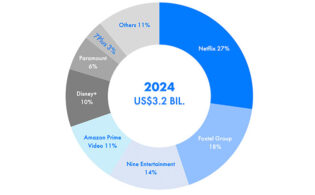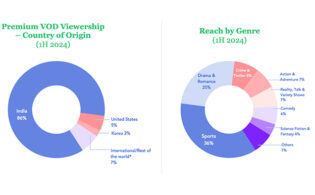Content investments in seven Asia-Pacific markets rose by 4 percent to $15.5 billion last year, with Media Partners Asia (MPA) forecasting a slower compound annual growth rate (CAGR) of 2.7 percent from 2024 to 2028.
The data was released in MPA’s 2024 Asia Video Content Dynamics report, tracking content investment, engagement and viewership across TV, VOD and theatrical in India, Korea, Indonesia, Philippines, Singapore, Thailand and Vietnam.
Last year’s 4 percent growth rate marks a significant slowdown from 2021 to 2022 amid a global reset of streamer budgets. India led the content gains with a 12 percent boost, largely driven by sports, with Indonesia at 5 percent. Korea, the Philippines and Thailand reported modest gains, while content spend fell in Malaysia and Vietnam.
Asian content is dominated by Korea and India, which accounted for 80 percent of all local content investments in 2023. Going forward, Korean growth is expected to be flat as streaming and film gains will be offset by reductions in TV investments. India, however, still has significant growth potential, with its local content spend expected to top Korea’s by 2026.
Across the seven markets, MPA anticipates a 2.7 percent CAGR gain in content investments to reach $17.2 billion by 2028, driven by India and, to a lesser extent, Indonesia and the Philippines. MPA projects “limited” gains in Korea and Thailand. Vietnamese content investments are expected to be challenged due to a weak ad market and piracy.
Free-to-air still leads in local content investments, accounting for 64 percent of spend in 2023, with streaming at 26 percent and film at 10 percent. TV will still be at more than 50 percent in 2028, with streaming rising to 33 percent.
Stephen Laslocky, MPA VP, noted: “Korean content continues to lead the pack with world-class production values and compelling storytelling, though we’re seeing online original content costs inflate to as much as $7 million per episode. Its extraordinary appeal is evident, accounting for over 30 percent of content demand in Southeast Asia and Taiwan. The rise of streaming has significantly elevated storytelling and production quality, particularly in Thailand and Indonesia, where competition is intensifying. We’re seeing content from these countries, especially Thai titles, gaining traction across Asia.
“It’s become clear that many traditional TV drama producers are struggling to compete with higher-end streamed video content. In contrast, quality film producers have embraced the flexibility of streaming and adapted with greater ease. Over the past year, as some ad revenues have permanently shifted to digital and streaming behavior has become entrenched, we’ve observed TV production margins contracting across most markets. For online originals, streamers have become much more disciplined in their approach to budgeting and content strategy.”
The report also highlighted YouTube’s dominance in online video, with the site having over a billion monthly active users across the surveyed markets—732 million are in India. TikTok has grown to 211 million total monthly active users across Indonesia, Malaysia, Philippines and Thailand.
In premium VOD, Netflix has between 40 percent and 70 percent of viewership in Korea, Indonesia, Malaysia and the Philippines but is seeing strong competition from the likes of TrueID in Thailand and Disney+ Hotstar and Jio Cinema in India.






